Do you have a question about the SMC Networks 6724L2 and is the answer not in the manual?
| Brand | SMC Networks |
|---|---|
| Model | 6724L2 |
| Category | Switch |
| Language | English |
Provides an overview of the SMC TigerSwitch 10/100, detailing its Fast Ethernet capabilities and management agent.
Explains the switch's architecture, its role in workgroups, and its support for optional fiber and Gigabit modules.
Details the hardware components of the switch, including Ethernet ports, media slots, and status LEDs.
Describes the 24 10/100BASE-T/TX ports and two slots for optional uplink modules, including auto-negotiation features.
Explains the function of port and system status LEDs located on the front panel for easy monitoring.
Details the built-in management agent, RS-232 serial port, and advanced performance-enhancing features.
Explains the support for IEEE 802.1D Spanning Tree Protocol for fault tolerance and preventing network loops.
Describes Virtual LANs (VLANs), their support for up to 256 groups, and benefits like broadcast storm elimination.
Explains multicast traffic management using IGMP Snooping and filtering for real-time delivery.
Details Quality of Service (QoS) implementation using priority queues and Weighted Round Robin Queuing.
Introduces optional slide-in modules for extending network connectivity, such as 1000BASE-SX.
Details the 1000BASE-SX Gigabit module for connecting to remote sites up to 550 meters using multimode fiber.
Details the 1000BASE-LX Gigabit module for connecting to remote sites up to 5 km using single-mode fiber.
Details the 1000BASE-T Gigabit module for twisted-pair connections up to 100 meters.
Details the 100BASE-FX module for single-mode fiber connections up to 20 km.
Describes the location and type of the AC power receptacle on the rear panel of the switch.
Highlights the key features and benefits of the TigerSwitch, including connectivity, expandability, performance, and management.
Details the switch's connectivity features, such as dual-speed ports, auto-negotiation, and MDI/MDI-X support.
Explains the expandability options through optional Gigabit and Fast Ethernet modules for various network needs.
Covers performance aspects like transparent bridging, aggregate bandwidth, switching table size, and non-blocking architecture.
Describes the management capabilities, including LEDs, management agent, and support for protocols like Telnet and SNMP.
Introduces network switching as a key technology, explaining its role in partitioning networks and improving bandwidth.
Presents typical applications for the TigerSwitch, such as collapsed backbone configurations for small LANs.
Details the collapsed backbone application, suitable for mixed Ethernet/Fast Ethernet installations and future growth.
Explains using fiber optic technology for long-distance connections, including Gigabit and 100BASE-FX modules.
Guides on configuring VLANs, including port-based and tagged VLANs, and their benefits for network segmentation.
Provides rules for network connectivity, including collision domains and maximum cable lengths for various Ethernet standards.
Offers practical notes on switch operation, including full-duplex, shared media connections, and routing considerations.
Provides guidelines for choosing an appropriate installation site, considering temperature, airflow, accessibility, and power.
Lists the items included in the package and other necessary equipment for installation.
Details the components included with the TigerSwitch 10/100 unit, such as the switch, cables, and documentation.
Specifies the equipment needed for rack-mounting the switch, such as mounting screws and a screwdriver.
Covers the methods for mounting the switch, either in a standard equipment rack or on a desktop or shelf.
Instructions for installing optional slide-in media expansion modules before mounting the switch.
Details factors to consider and steps for rack mounting the switch, including temperature, loading, and grounding.
Provides instructions for mounting the switch on a flat surface or shelf using adhesive feet.
Step-by-step guide on how to safely install optional slide-in modules into the switch.
Explains how to connect the switch to a power source, including checking power LEDs and international considerations.
Guides on interconnecting the TigerSwitch with PCs, servers, hubs, switches, and routers using various network cards.
Details the requirements for twisted-pair (UTP) cables and RJ-45 connectors for connecting devices to the switch.
Provides guidelines for using twisted-pair cables with RJ-45 connectors, including MDI/MDI-X operation and cautions.
Step-by-step instructions for making twisted-pair connections to end devices and verifying link status.
Explains how to make connections within a wiring closet using punch-down blocks and patch panels.
Describes the use of optional fiber optic modules for backbone and long-distance connections, including warnings about laser safety.
Provides a troubleshooting chart for diagnosing issues based on switch indicator LEDs (Power, Link, Status).
Offers solutions for power indicator issues, fan obstructions, and power surges, suggesting contact with support.
Guidance on verifying proper installation of system components and testing them in an alternate environment.
Troubleshooting steps for establishing in-band management access via Telnet or Web browser, including IP configuration checks.
Lists cable types, specifications, maximum lengths, and connector types for various Ethernet and Gigabit Ethernet standards.
Details pin assignments for RJ-45 connectors used with twisted-pair cables and provides cautions for proper use.
Specifies pin assignments for 100BASE-TX/10BASE-T connections, including MDI and MDI-X port pinouts.
Details pin assignments for 1000BASE-T connections, including MDI and MDI-X port pinouts and cable requirements.
Details cable requirements for 1000BASE-T, including testing and adjustments for Category 5 cabling.
DB-9 serial port pin assignments for console configuration and connection to PC serial ports.
Details physical characteristics: ports, interface, buffer, bandwidth, LEDs, weight, size, temp, humidity, power, consumption.
Details In-Band Management, Out-of-Band Management, Software Loading, MIB Support, RMON Support, and Additional Features.
Lists various IEEE standards supported by the switch, including Ethernet, Fast Ethernet, Gigabit Ethernet, VLAN tagging, and Spanning Tree Protocol.
Details compliance certifications like CE Mark, FCC Class A, Industry Canada Class A, VCCI Class A, and safety standards.
States the warranty period for the product as Limited Lifetime.
Details specifications for optional slide-in modules: 100BASE-FX, 1000BASE-SX, 1000BASE-LX, and 1000BASE-T.
Details models, ports, network interface, and standards for 100BASE-FX extender modules.
Details model, ports, network interface, and standards for 1000BASE-SX extender module.
Details model, ports, network interface, and standards for 1000BASE-LX extender module.
Details model, ports, network interface, and standards for 1000BASE-T extender module.
Lists product numbers and descriptions for the TigerSwitch 10/100 base unit, modules, and accessories.
Definition of 10BASE-T, specifying IEEE 802.3, 10 Mbps Ethernet, and cable types.
Definition of 100BASE-TX, specifying IEEE 802.3u, 100 Mbps Fast Ethernet, and Category 5 UTP cable.
Definition of 100BASE-FX, specifying IEEE 802.3u, 100 Mbps Fast Ethernet, and fiber cable types.
Definition of 1000BASE-SX, specifying IEEE 802.3z, Gigabit Ethernet, and fiber cable types.
Definition of 1000BASE-LX, specifying IEEE 802.3z, Gigabit Ethernet, and single-mode fiber cable.
Definition of 1000BASE-T, specifying IEEE 802.3ab, Gigabit Ethernet, and Category 5/5e UTP cable.
Definition of Auto-Negotiation, a signaling method for selecting optimum operational mode (speed, duplex) between nodes.
Definition of Bandwidth, referring to frequency range for signals and synonymous with wire speed.
Definition of Class I Repeater for Fast Ethernet, its limitations on internal delay and number per collision domain.
Definition of Class II Repeater for Fast Ethernet, its limitations on internal delay and number per collision domain.
Definition of Collision, where transmitted packets interfere with each other, making signals unintelligible.
Definition of Collision Domain, referring to a single CSMA/CD LAN segment.
Definition of CSMA/CD (Carrier Sense Multiple Access/Collision Detect), the communication method for Ethernet.
Definition of End Station, a device that does not act as a network interconnection, such as a workstation or server.
Definition of Ethernet, a network communication system standardized by DEC, Intel, and Xerox.
Definition of Fast Ethernet, a 100 Mbps network communication system based on Ethernet and CSMA/CD.
Definition of Fast Ethernet Switch, providing 100 Mbps bandwidth to each port.
Definition of Full Duplex, a transmission method allowing concurrent transmit and receive, doubling bandwidth.
Definition of Gigabit Ethernet, a 1000 Mbps network communication system based on Ethernet and CSMA/CD.
Defines CSMA/CD access method and physical layer specifications for Ethernet.
Defines CSMA/CD and physical layer specifications for 1000BASE-T Fast Ethernet.
Defines CSMA/CD and physical layer specifications for 100BASE-TX Fast Ethernet.
Defines Ethernet frame requests and timers for flow control on full-duplex links.
Defines CSMA/CD and physical layer specifications for 1000BASE Gigabit Ethernet.
Definition of LAN Segment, referring to a separate LAN or collision domain.
Definition of LED (Light Emitting Diode), used for monitoring device or network condition.
Definition of Link Segment, the cable joining repeaters or a repeater and a PC.
Definition of Local Area Network (LAN), a group of interconnected computer and support devices.
Definition of Media Access Control (MAC), governing access to the transmission medium.
Definition of MIB (Management Information Base), a set of database objects containing device information.
Definition of MII (Media Independent Interface), the standard interface for Fast Ethernet.
Definition of Network Diameter, the wire distance between two end stations in the same collision domain.
Definition of RJ-45 Connector, a connector for twisted-pair wiring.
Definition of Straight-through Port, an RJ-45 port that connects transmit and receive signals directly.
Definition of Switched Ports, ports on separate collision domains or LAN segments.
Definition of UTP (Unshielded Twisted-pair cable).
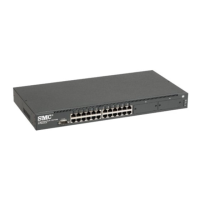
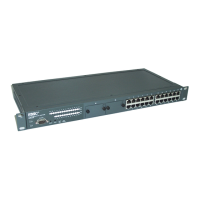
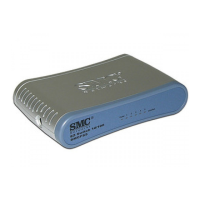
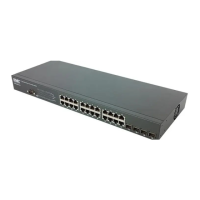

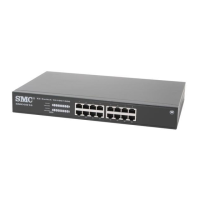
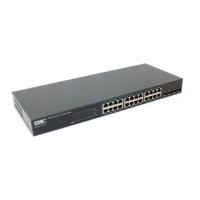
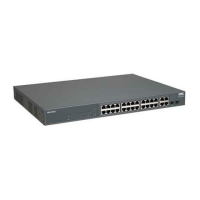
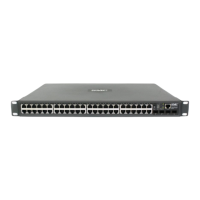
